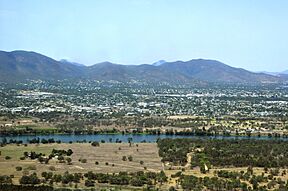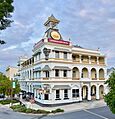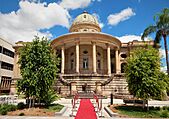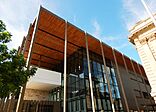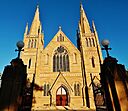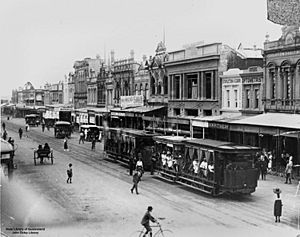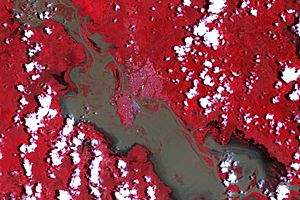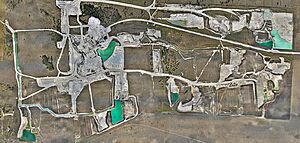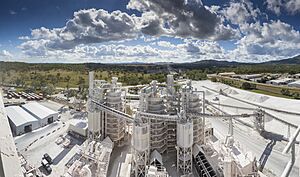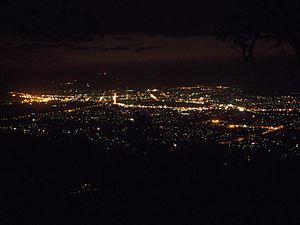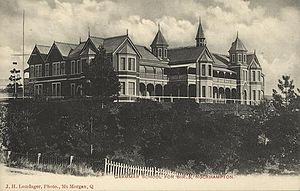Rockhampton facts for kids
Quick facts for kids RockhamptonQueensland |
|||||||||
|---|---|---|---|---|---|---|---|---|---|
|
Quay street historic district
The RMOA
Allenstown street art
French Purrey tram along Denison street
|
|||||||||
| Population | 81,021 (2022) (23rd) | ||||||||
| • Density | 139.7/km2 (362/sq mi) | ||||||||
| Established | 1858 | ||||||||
| Postcode(s) | 4700, 4701, 4702 | ||||||||
| Elevation | 11.3 m (37 ft) | ||||||||
| Area | 580 km2 (223.9 sq mi)(2011 urban) | ||||||||
| Time zone | AEST (UTC+10) | ||||||||
| Location | |||||||||
| LGA(s) | Rockhampton Region | ||||||||
| Region | Central Queensland | ||||||||
| State electorate(s) |
|
||||||||
| Federal Division(s) | Capricornia | ||||||||
|
|||||||||
Rockhampton is a city in Central Queensland, Australia. It's often called 'Rocky' by locals. In 2022, about 81,021 people lived here.
The city's name comes from the Fitzroy River, which has a "bar of rocks" that stopped boats from going further upstream. The first European settlers arrived in 1853. Gold was discovered nearby in 1859, leading to a big rush. This made Rockhampton a very important port. Later, more gold was found at Mount Morgan Mine, which helped build many of the city's beautiful old buildings.
Today, Rockhampton is known for its strong economy in tourism, health, and farming. It's also famous for its historic buildings, food, and music, especially jazz. Some people even call it the "Melbourne of the North" because of its wide streets and laneways. The city has many cool places to visit, like the Rockhampton Museum of Art and the Rockhampton Botanic Gardens.
Contents
Exploring Rockhampton's Past
Early History and People
The land around Rockhampton has been the home of the Darumbal Aboriginal people for a very long time. Their language region covers the city and surrounding areas. The Kangulu people also have connections to parts of Rockhampton.
How Rockhampton Began
British settlers, like the Archer brothers, arrived in 1853 looking for land for their animals. They found the Fitzroy River perfect for shipping goods. In 1858, the town of Rockhampton was officially created. It was designed with wide streets, similar to Melbourne.
Soon after, gold was found at Canoona in 1859. This brought many new people to Rockhampton, making it a busy port. Even though the gold rush didn't last long, many people stayed, helping the town grow.
Growing into a City
By 1861, Rockhampton had its own newspaper, banks, and schools. Ships started arriving directly from the United Kingdom, bringing goods and new people. The city became the main port for the Central Queensland area, mostly exporting wool.
In the 1880s, a huge gold discovery at Mount Morgan made Rockhampton even richer. This wealth helped build many of the grand brick and stone buildings you can still see today. Famous buildings like the Customs House (1900), Post Office (1892), and St Joseph's Cathedral (1892) were built during this time.
In 1892, the Anglican Church in Rockhampton was the first church in Australia to be lit by electricity!
A New State Idea
In 1889, some people in Rockhampton wanted Central Queensland to become its own state, separate from Queensland. They felt that the government in Brisbane was too far away to understand their needs. Women in Rockhampton even started their own group to support this idea, collecting over 3,000 signatures for a petition to Queen Victoria. However, the idea was not approved.
Rockhampton in the 1900s
Rockhampton officially became a city in 1902. Train lines connected it to Brisbane in the south and Longreach in the west, making it an even more important hub for Central Queensland.
From 1909 to 1939, Rockhampton was the only city in Queensland outside of Brisbane to have street trams! These were steam trams, but they were replaced by buses because they were too hot for the tropical climate.
In 1918, a very strong earthquake shook Rockhampton. It was the biggest earthquake ever recorded in Queensland since European settlement.
During World War II, a US army base was set up near the city. Up to 70,000 soldiers stayed there on their way to fight in the Pacific.
In 1971, the Fitzroy River Barrage was built. This dam helps provide a steady supply of fresh water for the city, protecting it from droughts.
Rockhampton's Location and Weather
Where is Rockhampton?
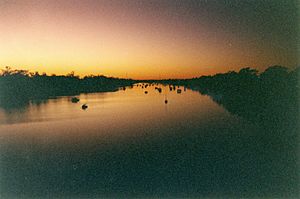
Rockhampton is located on the Fitzroy River, about 45 kilometers from the ocean. It's about 600 kilometers north of Brisbane. The city is split into a north and south side, connected by three bridges.
The city is just north of the Tropic of Capricorn. This is an imaginary line around the Earth. Rockhampton is right in the middle of a special area where tropical and temperate plants and animals mix.
Rockhampton's Climate
Rockhampton has a warm climate with long, hot, and humid summers. Winters are short and warm. The city gets about 125 clear days each year.
Because it's in a cyclone risk zone, Rockhampton has experienced several large cyclones. The city also gets summer thunderstorms and often has fogs in winter and early spring.
The Fitzroy River in Rockhampton has a long history of flooding. The highest flood ever recorded was in 1918, reaching over 10 meters! More recently, in 2011, the river peaked at 9.2 meters during the 2010–2011 Queensland floods.
The hottest temperature ever recorded in Rockhampton was 45.3 degrees Celsius, and the coldest was -1.0 degrees Celsius.
How Rockhampton is Run
Rockhampton is governed by the Rockhampton Regional Council. The council has a mayor and seven councillors. They are elected by the public every four years.
The current mayor is Tony Williams. The Rockhampton Regional Council area was formed in 2008 by combining several smaller areas.
Rockhampton's Economy
Farming and Cattle
Farming, especially the cattle industry, is very important in Central Queensland. Rockhampton is even known as the Beef Capital of Australia! You can see seven large bull statues around the city, celebrating this industry.
There are two big meat processing factories near Rockhampton. They provide many jobs for people in the city. The Central Queensland Livestock Exchange at Gracemere is one of the largest places in Australia for selling livestock.
Every three years, Rockhampton hosts the Beef Australia Expo. This big event celebrates the local cattle industry.
Military Presence
Rockhampton has an Australian Defence Force base. Nearby is the large Shoalwater Bay Military Training Area. Because of this, you often see military vehicles and personnel in the city. When big military exercises happen, soldiers from other countries also visit, which helps the local economy.
Tourism in Rockhampton
Tourism is becoming more and more important for Rockhampton. Many tourists stop here overnight on their way north from Brisbane. They can visit local attractions and spend money in shops and restaurants.
Popular tourist spots include the Capricorn Coast (just a 30-minute drive away), the historic buildings in the city center, the Rockhampton Heritage Village, the Dreamtime Cultural Centre, and the Rockhampton Botanic Gardens.
Other Industries
Rockhampton also has industries in transport, manufacturing, mining, and energy.
The rail company Aurizon has a large team in the city. Rockhampton is where the main north coast railway line meets the lines going to the big coalfields in the west.
The Stanwell Power Station, a large coal-fired power plant, is located west of the city. It provides many jobs for people living in Rockhampton.
Queensland Magnesia (QMAG)
Queensland Magnesia (QMAG) is a company that produces special magnesia products. They mine magnesite at Kunwarara, north of Rockhampton, and process it at their plant in Parkhurst. Over 200 local people work there.
Magnesia is used in many ways:
- For insulation in very hot industries like steel and glass making.
- As a supplement for animal feed and fertilizer for plants.
- To help make nickel and cobalt for electric vehicle batteries.
- In industrial uses like treating wastewater.
Rockhampton's Culture and Fun
Rockhampton hosts many concerts, events, and festivals throughout the year.
The annual Rockhampton Cultural Festival in August celebrates different cultures with food, music, and displays. The Rockhampton Showgrounds also host many events, including the three-day Rockhampton Show every June.
Rockhampton was one of the first cities in Australia to hold an early morning service for Anzac Day on April 25, way back in 1916.
The Pilbeam Theatre, opened in 1979, is Rockhampton's biggest theater. Next to it is the Rockhampton Art Gallery, which has many works by Australian artists.
The Rockhampton Music Bowl hosts events like the annual Carols by Candlelight in December.
Rockhampton has also been a filming location for movies like The Kid Stakes and Buddies.
Sports in Rockhampton
Rockhampton has many local sports teams and clubs.
- Australian rules football: Brothers Roos, Glenmore Bulls, Rockhampton Panthers.
- Basketball: Rockhampton Rockets (men's), Rockhampton Cyclones (women's).
- Cricket: Many senior and junior clubs like Frenchville Falcons and North's Tigers.
- Football (Soccer): Capricorn Cougars FC and Central Queensland.
- Mountain biking: The Rockhampton Mountain Bike Club has three trail networks.
- Roller Derby: Rocky Roller Derby – "Beef City Brawlers".
- Rugby league: Central Queensland Capras (representative team), and local clubs like Fitzroy-Gracemere Sharks.
- Rugby union: Rockhampton Brahmans.
- Touch Football: Rockhampton Redbacks.
Places to Visit
- Rockhampton Botanic Gardens: Opened in 1869, these gardens have amazing palms, cycads, and ferns, some over 100 years old.
- Rockhampton Zoo: Located next to the Botanic Gardens, you can see koalas, chimpanzees, saltwater crocodiles, red kangaroos, and the rare cassowary.
- Kershaw Gardens: These gardens focus on Australian native plants and have a cool imitation waterfall.
- Dreamtime Cultural Centre: Australia's largest cultural center, it covers 12 hectares with native plants and waterfalls. You can learn about Torres Strait Islander culture, hear didgeridoo playing, and see traditional dancers.
- Archer Park Steam Tram Museum: This museum is in the old Archer Park rail station (built in 1899). It tells the story of the station and the unique Purrey Steam Tram.
- Mount Archer National Park: Rising from the city's edge, Mount Archer offers amazing views of Rockhampton. Frazer Park at the top is about 604 meters above sea level.
- Capricorn Caves: Just a short drive north of Rockhampton, these caves are a popular attraction.
Education in Rockhampton
Rockhampton is an important education center. The first school, The Rockhampton National School, opened in 1859.
CQUniversity Australia started in Rockhampton in 1967. Now, it has over 30,000 students across 24 campuses in Australia! It offers many different courses, from short programs to university degrees.
Rockhampton has several high schools, including Rockhampton State High School, North Rockhampton State High School, Rockhampton Grammar School, and The Cathedral College, Rockhampton.
Media and News
Newspapers
Rockhampton has had many newspapers over the years. The Morning Bulletin is the only daily newspaper still published today. It started in 1861.
Radio Stations
Rockhampton has many radio stations, including national, commercial, and community stations.
- 4RO (AM) and 4CC (AM) play classic hits.
- Triple M Central Queensland (FM) and Hit Central Queensland (FM) play popular music.
- ABC Capricornia (AM) is the local ABC station, with local news and shows.
- Triple J, RN, ABC Classic FM, and ABC NewsRadio are other ABC stations available.
- 4YOU (FM) and 4US (FM) are local community stations.
- KIX Country (FM) plays country music.
| Callsign | Frequency | Owner |
|---|---|---|
| 4RO | 990 kHz AM | Grant Broadcasters |
| 4CC | 1584 kHz AM | Grant Broadcasters |
| Triple M Central Queensland | 101.5 MHz FM | Southern Cross Austereo |
| Hit Central Queensland | 107.9 MHz FM | Southern Cross Austereo |
| Triple J | 104.7 MHz FM | ABC |
| Radio National | 103.1 MHz FM | ABC |
| ABC NewsRadio | 105.5 MHz FM | ABC |
| ABC Classic FM | 106.3 MHz FM | ABC |
| ABC Capricornia | 837 kHz AM | ABC |
| 4YOU | 98.5 MHz FM | Community |
| 4US | 100.7 MHz FM | Community |
| KIX Country | 92.7 MHz FM | Grant Broadcasters |
| Radio TAB | 99.9 MHz FM | UBET |
| Vision Radio | 87.6 MHz FM | United Christian Broadcasters |
Television
Rockhampton has five main TV channels:
- Seven Queensland
- Southern Cross 10
- WIN Television Queensland
- ABC TV
- SBS TV
These channels offer many other digital channels like ABC Kids, ABC TV Plus, SBS Viceland, 10 Bold, 7two, and 9Gem. Foxtel also provides paid satellite TV.
Local news is important! Seven Queensland has a 30-minute local news bulletin. WIN Television also has a regional bulletin with Rockhampton news.
Getting Around Rockhampton
Transport Links
Rockhampton is a key transport hub in Central Queensland. It connects the Central Highlands and Capricorn Coast regions to the rest of the state.
The city is located where major highways meet: the Bruce Highway (coastal), the Capricorn Highway (western), and the Burnett Highway (hinterland). It takes about seven and a half hours to drive from Brisbane to Rockhampton.
Long-distance buses connect Rockhampton to Brisbane in the south and Cairns in the north. Local bus services operate throughout the city.
Rockhampton railway station is on the North Coast railway. You can catch the Electric Tilt Train to Brisbane or the Diesel Tilt Train to Cairns. Interestingly, in some parts of Rockhampton, the main train line runs right down the middle of the street!
Rockhampton Airport is about 6 kilometers west of the city. It's one of Australia's busiest domestic airports, with flights to major cities and regional areas. It's also a base for the Royal Flying Doctor Service and the Rescue Helicopter.
Road Train Access
Recently, roads around Rockhampton were improved to allow large "Type 1 Road trains" (very long trucks) to access the Gracemere saleyards and Rockhampton abattoirs. This project cost $30 million and improved about 29 kilometers of roads.
Water Supply
The Fitzroy River has a huge catchment area, almost the size of England! This means Rockhampton and Central Queensland have plenty of good water. The Fitzroy River Barrage at Rockhampton keeps salt water separate from fresh water upstream, providing water for homes and industries.
Power Supply
Central Queensland has major power stations, like Stanwell Power Station, which produce most of the state's electricity. The Stanwell power station, located 28 kilometers west of Rockhampton, is very modern and provides many jobs.
Sister City
Rockhampton has a sister city:
- Ibusuki, Japan (since 1980)
See also
 In Spanish: Rockhampton (Queensland) para niños
In Spanish: Rockhampton (Queensland) para niños


